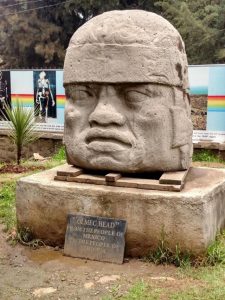A little bit of History
 ¿Do you know why is there a Mexican Olmec Colossal Head at the Ethnological Museum in Addis Ababa?
¿Do you know why is there a Mexican Olmec Colossal Head at the Ethnological Museum in Addis Ababa?
Ethiopia, the same as Mexico, has always been a defender of freedom and justice. The friendship that developed between the two countries is based on the following facts.
 If you ride the underground line number 3 in Mexico City you will arrive at a station called “Ethiopia” (since 2008 renamed Ethiopia – Square of Transparency).
If you ride the underground line number 3 in Mexico City you will arrive at a station called “Ethiopia” (since 2008 renamed Ethiopia – Square of Transparency).
If you are curios enough you will discover among the lion sculptures decorating the platform a commemorative plaque dedicated to the mythical visit of the last Ethiopian Emperor, Haile Selassie I, to México in 1954.
Haile Selassie I was crowned emperor of Ethiopia on November 2nd, 1930.
By 1935, most of the African Continent had been divided up among the main European powers and there were few territories left to be conquered. Italy already possessed Eritrea and Somalia and Ethiopia was an obstacle for expanding Italy’s influence over what is known as the Horn of Africa. In 1935, Benito Mussolini invaded Ethiopia. Italy’s military supremacy obliged Emperor Haile Selassie I to escape to London from where he appealed to the Society of Nations (later Organization of United Nations) to denounce the arbitrary occupation of his country.
Mexico, together with only four other member countries of the Society of Nations, decidedly opposed Italy’s occupation of Ethiopia. The Mexican Government, under the Presidency of Lázaro Cárdenas, was the first to pronounce its unconditional support for the swift restoration of Ethiopian sovereignty. The other four countries following in the footsteps of Mexico were the Soviet Union, the United States of America, New Zealand and Haiti. This support by the Mexican Government was something the Ethiopian Emperor never forgot.
In 1941, British and South African troops liberated Ethiopia and Haile Selassie could return to his home country.
Thirteen years later, in 1954, he visited Mexico. Haile Selassie was the first Chief of State of an African country to visit Mexico. He explicitly came to thank the then President of Mexico, Adolfo Ruiz Cortines, for the backing he had received from the Mexican Government during his appeals before the Society of Nations against the unlawful invasion and occupation of his country.
The most significant act during the Emperor’s visit was the inauguration of the “Glorieta de Ethiopia” (Ethiopia Square) in downtown Mexico City. In correspondence, Emperor Haile Selassie promised to create an equal square dedicated to Mexico in the Ethiopian Capital of Addis Ababa. The Mexico Square was concluded four years later. Thus the two nations sealed their friendship and bonding, and in 1963, Embassies were opened in both Capitals.
However, there were times when the relationship between the two countries was not all that cordial, particularly after the imperial dynasty of Haile Selassie came to an end in 1974 and a soviet inspired government took over the country. But in moments of crisis and tragedy, the nations came together again. During the terrible draughts that devastated Ethiopia during the 1980 and 1990, Mexico sent grains and food to the African country, and after the earthquake of 1985 that destroyed a huge part of Mexico City, Ethiopia donated money for the victims.
To commemorate Mexico’s assistance to Ethiopia during its occupation by Italy, in 2010 the Mexican government donated a replica of an Olmec colossal head to Ethiopia where it was originally placed in the Mexico Square and can now be found outside the Ethnological Museum.
